Dear ,
Greetings. Reaching out to discuss a business collaboration. We provide innovative solutions like X,Y, Z. We’re an ABC company.
I look forward to meeting with you to explore our collaboration.
Regards,
Name,
ABC company.
Here are some questions off the top of a reader’s mind: Dear who? Greetings for when? Business collaboration…Why? Meeting….What?
BTW, that’s a real cold email we received. The subsequent follow-ups in the email thread, at least 5-6 of them, were far from acceptable. The only thing this email does is make us question the sales person, and the organization.
Plus – If the content of the email doesn’t matter to us or our business, why message us at all?
So many good sales opportunities meet its death the second a poorly written cold email or follow-up touches the inbox. From unnecessarily long and detailed subject lines to informal lingo in the email copy, there are a lot of things you shouldn’t add to your sales email.
In this story, we’ll give you a complete rundown of the most common mistakes reps make when writing cold emails and follow-ups by breaking down real-life bad email examples.
Writing Perfect Cold Emails: Before we dive into bad cold emails, here’s where you can learn how to write an effective cold email.
Example 1 – Too Focused on Self, What’s in It for the Receiver?
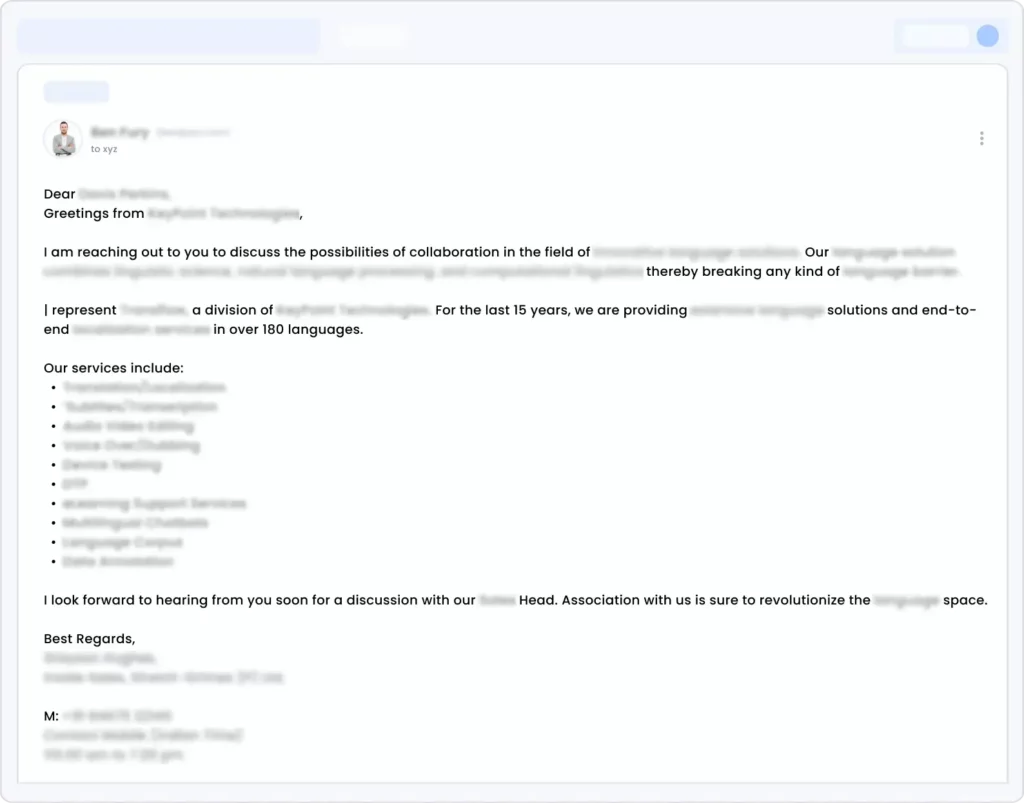
What’s Wrong With the Email?
- Irrelevant to the Reader:
While you may not understand the contextual nuance of the email since you don’t know the sender or the receiver, let us explain. This situation can be equated to a scenario where, say, a person was selling propulsion engines and they pitched to a carpenter company. In this scene, the sender did not do proper targeting.
- The First Line Talks About Their Product:
Not only did this sender get the target audience wrong, they also go on to assume that the sender will find their product offerings useful and that they’re going to get a meeting. A classic example of throwing darts in the dark.
- No Benefit Mentioned for the Reader:
This email doesn’t explain what’s the benefit for the reader, or the reason why they’re messaging the reader in particular. Right now they’re just spraying what their product does to a large crowd and praying that someone has a need for it.
- Immediately Assuming That the Reader Will Talk to Them:
The sender is audaciously assuming that the reader will talk to them. Unless you’ve connected with them before, you shouldn’t assume that the prospect will give away 15 minutes of their time for a sales call. Instead, you could use permission-based CTAs to end your cold email and follow-ups. For example, ask them if it’s okay to send over a couple of insightful assets they can get value from.
Example 2 – Too Many Colored-fonts End up in Trash

What’s Wrong With This Email?
- The Color of the Text, the Random Formatting:
There are two colors of fonts, and random bolding peppered throughout the email. While the intention to stand out from the inbox is good, this isn’t the way to go about it. At first glance, people may be irked by the different colors because colorful text, randomly bolding, too many exclamation points, or random capitalizations, too, are usually associated with spam emails.
What should you do instead:
The maximum you can go with changing the format is not using uppercase when writing ‘Hi’ and the first line of the email. That may catch the reader’s attention. Also, pay attention to the content of your email. Is it personalized to the reader? Does it have a ‘What’s in it for me’ for the reader? Does it have a clear CTA?
Example 3 – Abbreviations Should Stay In Whatsapp Chats
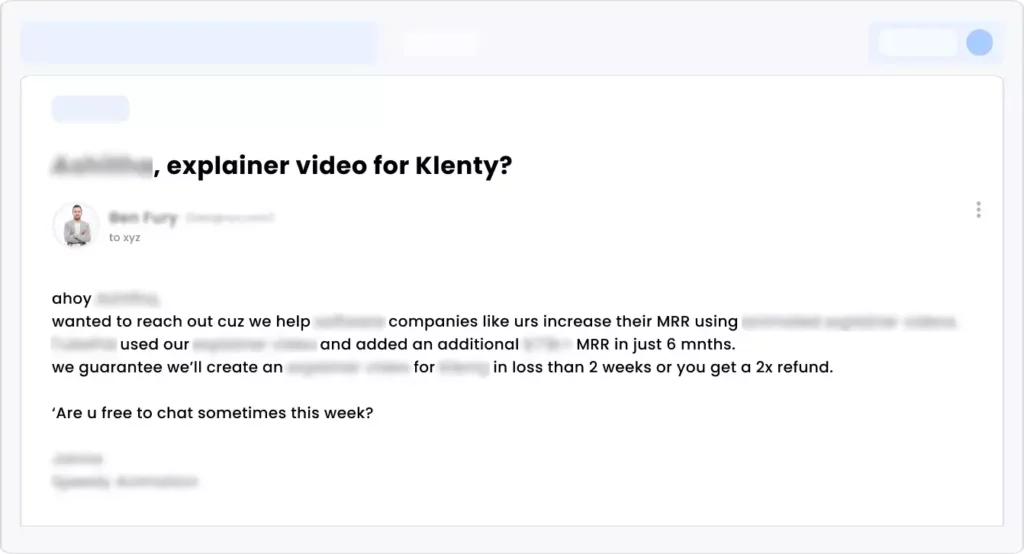
What’s Wrong With This Email?
While the content, and pattern breaks in this email are wonderful, this SDR loses the reader’s attention the moment they read short forms. First lesson, know your audience.
Using short forms like ‘urs’ and ‘cuz’ while messaging a content head, someone who’s getting paid to notice grammatical errors and spelling mistakes, was a lapse in judgment.
This email had actually got a couple of things right–like the pattern interrupting opener, the ‘What’s in it for me’ for the reader, showcasing the social proof–a good mix of things that could get the prospect excited.
But they failed to win trust because of these minor errors:
- They used abbreviations which lend the email untrustworthy
- They did not include any links to the website or their linkedin page for the prospect to browse through.
Example 4 – Don’t Use Sir/Ma’am Salutation
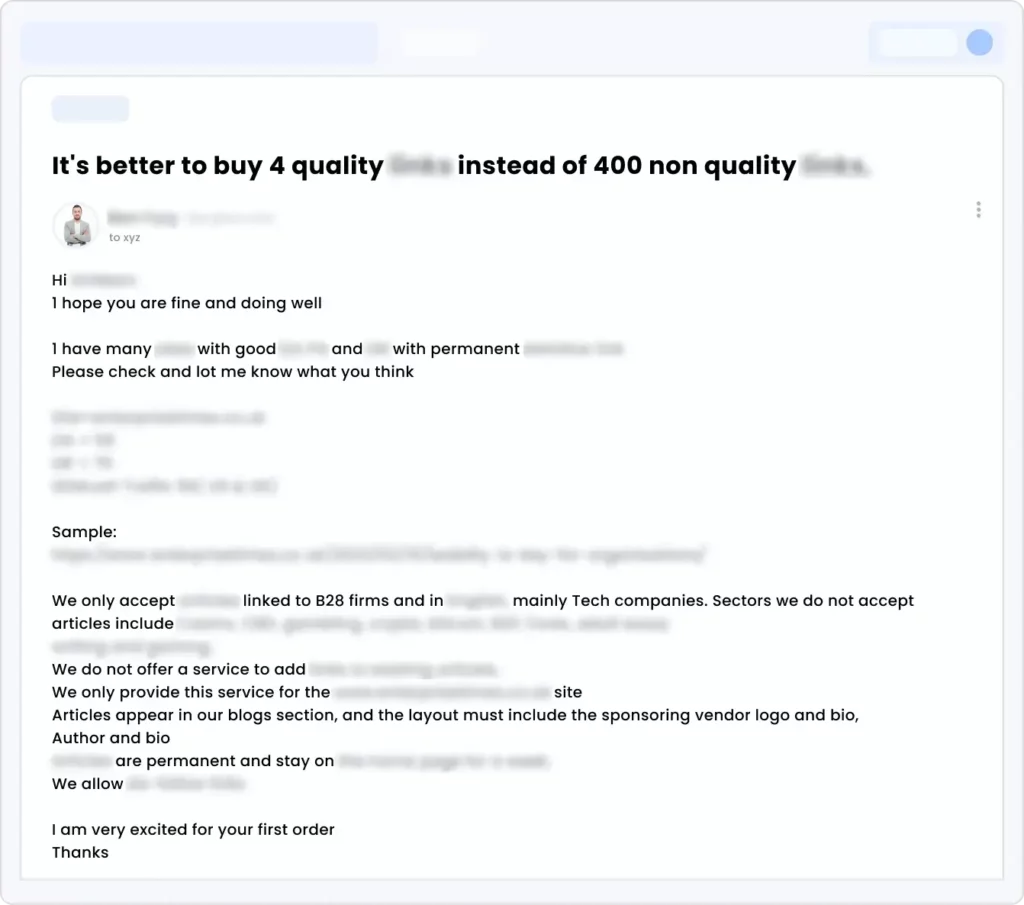
What’s Wrong With This Email?
- Stop using Sir/Mam salutations:
In B2B prospecting, it’s not recommended in any circumstance to use “Sir/Mam”. Using such salutations is a cultural way to open an email in some countries. But when you’re prospecting on a global platform, stick to ‘Hi’ or ‘Hello’ or you could even forgo the salutation completely to break the prospect’s reading pattern.
- Don’t copy and paste:
This is definitely part of a large spray and pray campaign considering a) it doesn’t have any personalization and b) the content has clearly been copied and pasted from elsewhere. Using templated emails is totally fine, copy and pasting content from elsewhere, too, but format it before you put your email together. Make sure you use a single font size, and a single color. And when you want to highlight a particular point, italicize or bold it.
Example 5 – Stop Giving Pleasantries Any Real Estate
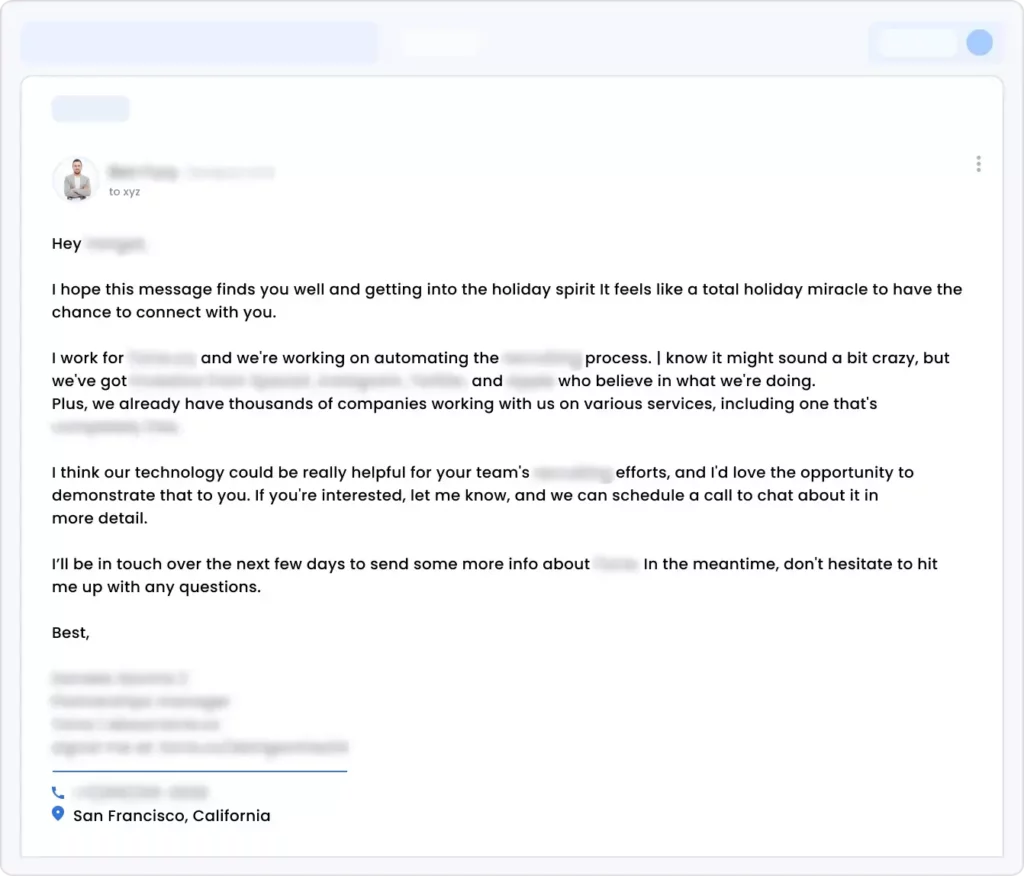
What’s Wrong With This Email?
- Wasted a lot of space on pleasantries:
This email was targeted at a C-suite executive. CXOs are aware that you’re trying to sell something in cold emails, so they’d simply prefer to get directly to the point, or you have to try to win their attention with a small amount of personalization in the introduction of the email. The cold email is your real estate to use judiciously to win their attention, don’t waste it on pleasantries.
- Relies only on social proof & mentions no value-add:
The rep here is focusing on trying to win over the prospect with just the power of social proof. They do not explain the benefit for the prospect. Social proof is obviously a great way to get someone’s attention but we know better than to put all our eggs in one basket.
What to do instead?
Social proof is a formidable weapon to highlight how the benefit you’re providing is validated by others in the industry. It’s even better if you mention how you have helped competitors achieve a goal that the prospect is probably currently behind on.
G2’s top-performing SDR, Nanditha Menon, tells us in our SDR X Factor series how she uses social proof to create FOMO in her cold emails.
She’d write, ‘Hey, this is what your competitor is doing. This is something you’re way behind on in the game, and it’s something you’re missing out on.’ She would also attach statistics to support her claim to convince the prospect that they’re indeed lagging behind their competitors.
Bonus: Since you’re looking at bad examples of cold emails, we thought it may help you if you also check out bad examples of follow-up and break up emails. To the prospect you’re sending this to, all of the emails in your sequence are probably cold emails. In that way, we suggest you optimize all of your sales emails to get more replies.
Example 6 – Proof that Humor Is Subjective
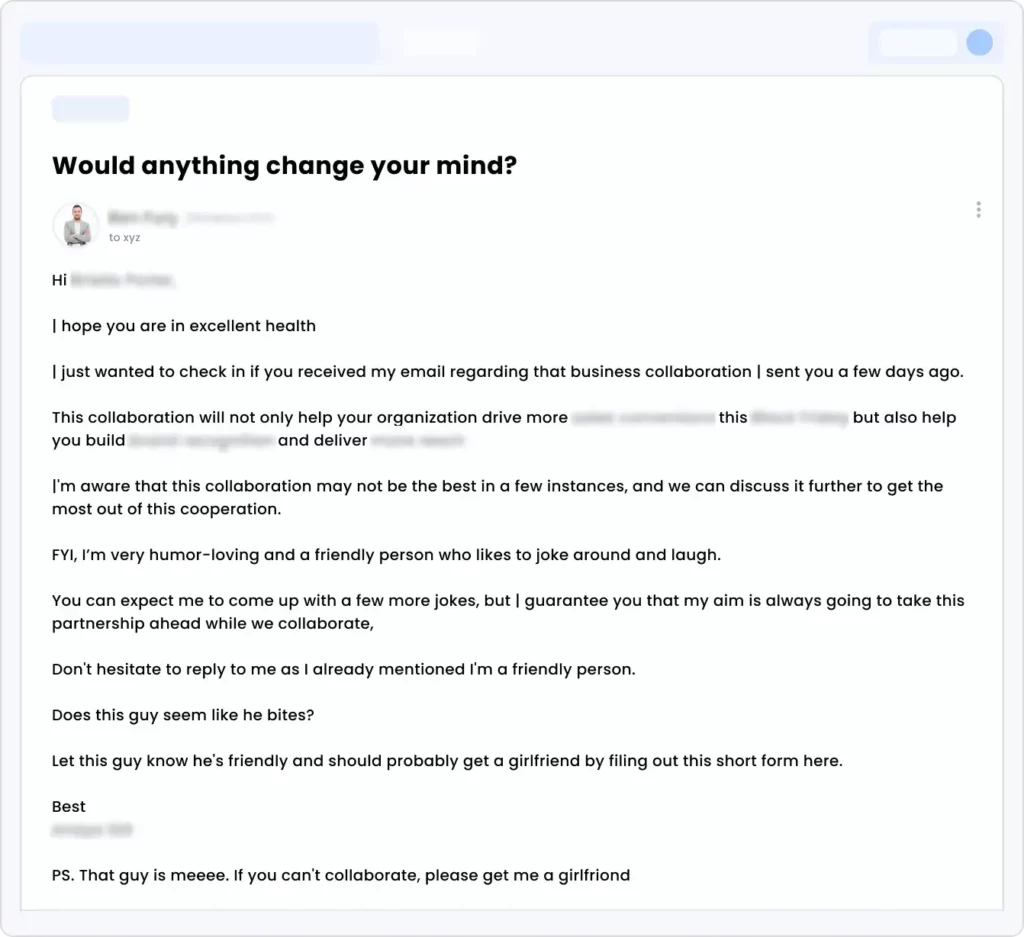
What’s Wrong With the Email?
- The Sender Thought This Was Funny:
It’s one thing to consider something funny and another thing completely to not be able to understand that humor is subjective. What you find funny may not evoke the same laughs from another person. If the receiver is a woman, this is going to leave them uncomfortable.
- This Break up Email Is Too Emotional:
A golden rule to follow (or take a print out of and stick in your office) is that you should never sound passive aggressive, or be too emotional in a bid to guilt trip the reader. That is going to leave a bitter memory in your prospect’s mind.
Example 7 – Zero Context Follow-up Emails End-up Unanswered
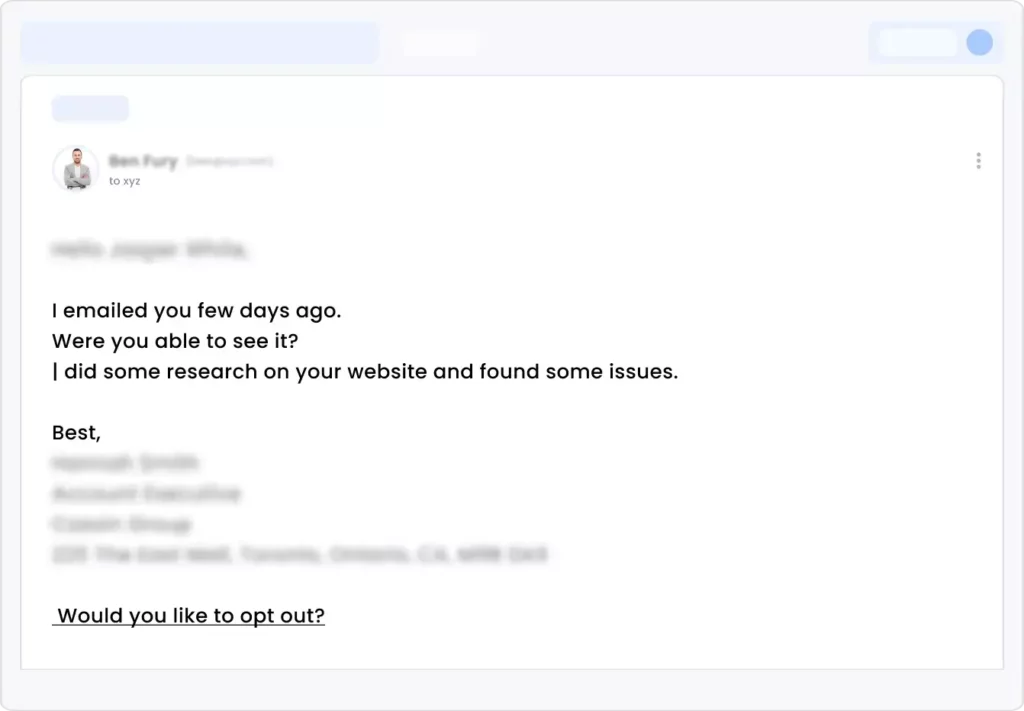
What’s Wrong With This Email?
For context, this email was sent to a c-suite executive.
- The Sender Gives No Context About the Previous Email:
This email was sent to a founder, who is probably caught up the whole day or week, and would have no time to recollect who sent the email.
What should you do instead: If you’re emailing a C-suite executive, you need to mention the context of the email–information like have you connected with them before, what did you connect about?, what is the current email about, and what do you want them to do now?
- There’s No Call to Action:
This email doesn’t mention any call to action. A cardinal sin, for marketers. But it can be one for salespeople as well. Here’s why: Firstly, they have already given you a minute–to read your sales email–and if you don’t clarify what you want from them, they will ignore your email. The prospect, on their busy day, will not go deciphering what you want them to do because of what’s called the decision fatigue’.
Psychiatrist Dr. MacLean sheds light on the topic, “by the time the average person goes to bed, they’ve made over 35,000 decisions and all of those decisions take time and energy, and certainly can deplete us.” So, when you leave the decision making up to the prospect, expect no engagement from them as there’s a high chance they will ignore it.
So, what should you do instead: Why not make their lives easier and tell them what they should do? Whether it’s to download an ebook, click on a link you sent or book a meeting with you, they can decide in a quick second, at least they won’t ignore you.
Write Perfect Email CTAs: Here’s 10 techniques to write that perfect CTA that’ll motivate your prospects to take the next step.
9 Email Etiquette Mistakes That Put off Recipients
From having poor email etiquette to missing out crucial elements you should have included in an email- both of which we saw in the bad email examples above-there are many ways reps err when writing a professional email.
These mistakes can crop up if you’re multitasking or are highly stressed (which, let’s admit you always are, and, to be honest, is completely normal)
- Writing a lengthy cold email: Whatever you ask in the cold email, however well-positioned, will remain unread if it’s longer than 120 words. Considering that you haven’t got their trust yet, why would they read paragraphs and paragraphs of text?
- Your first line is generic: The first line of your cold email plays a vital role in getting replies if not at least some kind of engagement from the prospect. Stop opening cold emails with small talk. It wastes their time, and also yours. They don’t know you at all to engage with you in conversations about the weather or their health. Ideally, personalize the first line in your email and include the reason you’re reaching out to them.
- Throwing in a weak line: Let’s talk CTAs. In order to drive people to take action upon reading your email, you’ve got to start asking for the right things. Revenue intelligence software, Gong, in its study revealed that specific CTAs that ask for the prospect’s interest have a much higher probability of taking the conversation forward than when you ask for a meeting.
- Using a clickbait subject line – This will not only piss your prospect off, it will also erode their trust in you–from the get go. So write subject lines that drives curiosity, or provokes thoughts. Look for ways to write subject lines without relying on clickbait.
- Using an informal email ID – This will make your good email sound unprofessional and amateurish.
- Making basic grammatical errors – If you’re messaging c-suite executives or leaders, this may be a deal breaker. Also multiple typos in a cold email can signal to the prospect that the sender cannot be trusted. Use a tool like Grammarly to automatically fix simple typos and punctuation errors.
- Overusing uppercase caps, exclamation marks – Using capitalizations randomly and one too many exclamation marks points to 1. You’re using it solely to get their attention, 2. Spam (because such writing is commonly found in spam emails.)
- Using ‘Dear’ to open your cold emails – Stay away from using the word ‘Dear’ to address your prospects. It actually has a lot to do with cultural nuances. In a lot of non-English speaking countries using ‘Dear’ to open conversations may be normal as it’s a widely-accepted way of being formal. But in English-speaking countries, ‘Dear’ is often used in personal communication, so using it in a professional setting can render the usage in business emails unfitting.
- Not including contact info – Do not forget to add your contact information in your cold email. That’s your full name, phone number, company name and address, LinkedIn profile would also be a great addition.
In a Nutshell
Remember the audience you’re trying to reach with your cold email. If you’re emailing a c-suite executive, keep it short, well-formatted, formal and error-free. Feel free to add emoticons or emojis, sentiment and sparkle if you know you’re reaching someone young.
But then again, some rules of emailing are set in stone, and following them would be your best bet at getting a response. Here’s how to write a great cold email by following the rules mentioned above:
Mention links to your LinkedIn profile, your company’s website, and how they can reach you. This will establish credibility.
- Create a professional from line
- Write a click-worthy not clickbait email subject line
- Something about the recipient’s pain point or current problems.
- Make your email body relevant to the reader
- Your opening line should catch their attention so personalize.
- Explain what’s in it for them. Don’t go feature-dumping.
- Give a call-to-action to engage the prospect
- Add a great email signature to sign off on a good note

